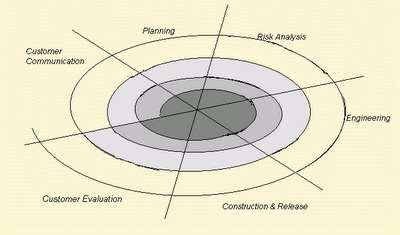skip to main |
skip to sidebar

Developed by Barry Boehm in 1988. it provides the potential for rapid development of incremental versions of the software. In the spiral model, software is developed in a series of incremental releases. During early iterations , the incremental release might be a paper model or prototype.Each iteration consists ofPlanning, Risk Analysis, Engineering, Construction & Release & Customer Evaluation.Customer Communication: Tasks required to establish effective communication between developer and customer.Planning: Tasks required to define resources, timelines, and other project related information.Risk Analysis: Tasks required to assess both technical and management risks.Engineering: Tasks required to build one or more representatives of the application.Construction & Release: Tasks required to construct, test, install and provide user support (e.g., documentation and training)Customer evaluation: Tasks required to obtain customer feedback based on evaluation of the software representations created during the engineering stage and implemented during the installation state.

In a typical model, a project begins with feasibility analysis. On successfully demonstrating the feasibility of a project, the requirements analysis and project planning begins. The design starts after the requirements analysis is complete, and coding begins after the design is complete. Once the programming is completed, the code is integrated and testing is done. On successful completion of testing, the system is installed. After this, the regular operation and maintenance of the system takes place.
What is Software Development Life Cycle (SDLC)?The various activities that are undertaken when developing software are commonly modelled as a software development lifecycle. The software development lifecycle begins with the identification of a requirement for software and ends with the formal verification of the developed software against that requirement.The software development lifecycle does not exist by itself; it is in fact part of an overall product lifecycle. Within the product lifecycle, software will undergo maintenance to correct errors and to comply with changes to requirements. The simplest overall form is where the product is just software, but it can become much more complicated with multiple software developments, each forming part of an overall system to comprise a product.There are a number of different models for software development lifecycles. Some of the more commonly used models are:-> Waterfall Lifecycle Model-> Modified Waterfall Lifecycle Model-> V Lifecycle Model-> Progressive Development Lifecycle Model-> Iterative / Incremental Lifecycle Model-> Spiral Lifecycle Model-> Prototyping Model-> RAD Lifecycle Model
© blogger templates 3 column | Make Money Online


